Hōryūji Wakakusagaran:
Mural fragments from the scorched Ikarugadera temple are recovered. The discovery redraws images of the Asuka period in architectural history, art history, and related fields.
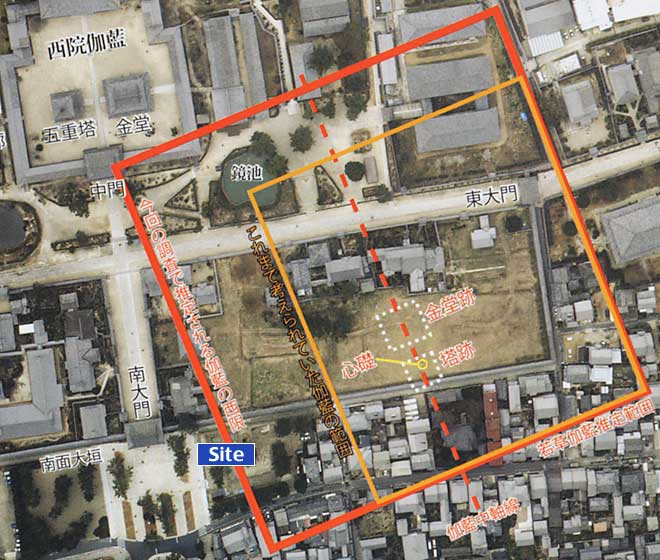
Wakakusagaran cloister and the excavation site
The orange line shows the extent formerly assumed for the Wakakusagaran cloister; the solid red line shows the extent as based on results of the current investigation. Both the main hall (larger rectangle drawn with a dotted white line) and pagoda (smaller rectangle) are seen to lie within the wall surrounding the modern precinct of Hōryūji. The excavation site is marked with characters highlighted in dark blue.
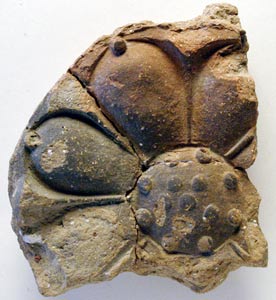
Unearthed round eave tile
|
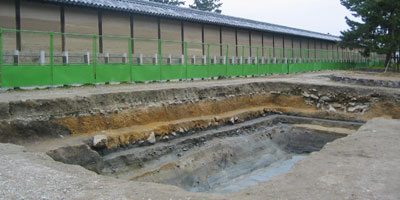
Detection of an old riverbed
|
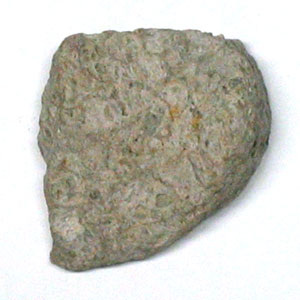
Petal tip portion from a lotus pedestal
|

Scorched roof tile
|

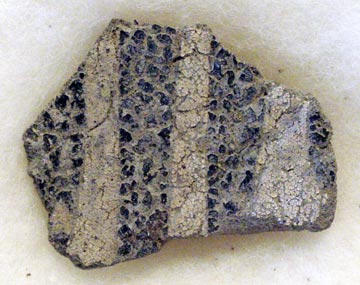

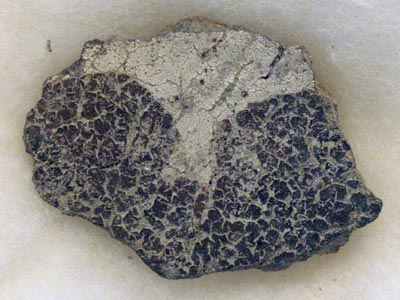
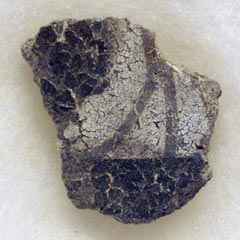
Scorched mural fragments
From examinations in cross section, the central portions of the walls were found to be made of coarse mud, topped with a 1.5 cm layer of finer earth, and finished with a plaster of 1-3 mm. Regarding the theme of the mural, points of resemblance with the Tenjukoku mandala, owned by Chōgōji temple, have been suggested by some observers.

Pigments remaining on a mural fragment
The flame-scorched lower half has discolored to a dark reddish-brown; from the results of fluorescent X-ray analysis it was discerned that iron and copper pigments were used.
Hōryūji Wakakusagaran Ruins, Ikaruga Town, Nara Prefecture
The Hōryūji Wakakusagaran ruins are the remains of an Asuka period temple adjacent to the southeast of Hōryūji's western cloister. From previous investigations the occurrence of a conflagration has been ascertained at this temple, thought to be the remains of Ikarugadera temple established by Prince Shōtoku.
The western cloister of Hōryūji is well known for having the oldest surviving wooden structures in the world, but with regard to their actual date of construction, from the Meiji period there has been a debate about whether or not Hōryūji was rebuilt; full clarification of the Wakakusagaran ruins, first discovered in an excavation in 1939, comprises a vital key to the resolution of this issue.
Asuka period artifacts emerge in large quantities from an old riverbed
In the current investigation, the remains of a valley and river dating from the Asuka period were detected to the southeast of Hōryūji's south gate. From within the valley's 2 m deep layer of deposit, scorched roof tiles of the Asuka period were recovered along with large quantities of earthen wall fragments. A ditch running north-south through the valley was also found, believed to form Wakakusagaran's western limit. It is thought that after the fire, scorched tiles and earthen wall remains were discarded here, to the west of the cloister.
Scorched mural fragments
Traces left by rice straw have been ascertained in the earthen wall fragments, and there are items with orange colored surfaces and those with grey surfaces, the latter inferred to have been subjected to temperatures of 1,000 to 1,200 degrees C. The color was found to have been applied after first drawing an outline across the surface, and from the results of fluorescent X-ray analysis iron and copper pigments were further detected, verifying that these are scorched mural fragments.
The mural fragments are small, mostly between 1 cm and 5 cm across, and the contents of the 200 items for which some design or coloration can be discerned are inferred to be Buddhist in nature, thought to have been drawn on the pagoda or main hall.
Mural artisans and masters
The Nihon shoki records the name of mural artisan Hakuka in the entry for the first year of the reign of Emperor Sushun (588), and makes reference in the entry for the twelfth year of the reign of Empress Suiko (604) to the Kifumi and Yamashiro groups of mural masters.
From the recovery of mural fragments in the current investigation, the participation of mural specialists from the start of temple building in Japan has received renewed recognition. Previously murals from temples have been uncovered for the latter half of the seventh to the eighth centuries, at the abandoned temple site at Kamiyodo in Tottori Prefecture and elsewhere, but as the recently discovered mural has been recovered in association with roof tiles of the first half of the seventh century, it can be called the oldest temple mural known for Japan.
The extant murals of the main hall and pagoda of Hōryūji are thought to follow the practice of solemnly decorating the interiors of Ikarugadera temple with murals.
Whither the debate from here?
The mural and roof tiles recovered from the current excavation will probably stand as archaeological proof of the Nihon shoki report of a calamity at Hōryūji in the ninth year of the reign of Emperor Tenji (670). Not only has this proved to be an extremely important find archaeologically, it should also lead to advances in various fields of research on the Asuka period, including history based on written documents as well as the histories of Buddhist art and of architecture. (Hirata Masahiko)
Hōryūji Wakakusagaran Ruins:
A small mural fragment closes a hundred-year debate
Was Hōryūji rebuilt or not?
Located in the town of Ikaruga in northwest Nara Prefecture, Hōryūji's origins trace back to the temple Ikarugadera, thought to have been built by Prince Shōtoku from a fervent wish that his father (Emperor Yōmei) recover from illness, and completed by Empress Suiko in the fifteenth year (607) of her reign.
There has been a debate since the Meiji period over whether the extant main hall and pagoda of Hōryūji belong to the temple founded by Prince Shōtoku. At question is whether or not Hōryūji was rebuilt. Historian Kita Sadakichi argued that the surviving structures represent a reconstruction made after the original temple was destroyed by fire, based on the Nihon shoki entry for the fourth month, third day of the ninth year (670) of Emperor Tenji's reign: "After midnight, fire at Hōryūji. Not a single building remains. There was great rain and thunder." In response, architectural historian Sekino Tadashi argued that since Asuka period characteristics are visible in the temple buildings, and the dimensions appear to have been based on old units of measurement, no substantive rebuilding occurred.
The discovery of Wakakusagaran
In 1939, an excavation was conducted in conjunction with the return to Hōryūji of a foundation stone for the central pillar of a pagoda, which had been removed from the temple grounds during the Meiji period. As a result, traces of the main hall, pagoda, and other features from a separate temple came to light in the southeastern portion of the modern temple precinct. This was the discovery of the Wakakusagaran ruins. From this the existence of a temple preceding the present Hōryūji became clear, and the view that Hōryūji was rebuilt in 711 has become the dominant theory.
Research based on dendrochronological dating
New information concerning the question of whether or not Hōryūji was rebuilt has come from research based on dendrochronological dating. Tree growth varies with climatic conditions such as rainfall and temperature, differences reflected in the widths of tree rings. Based on comparison with a standard pattern of variation constructed from living trees and extended back into the past, the age of old wooden materials can be measured. If the lighter sapwood around the circumference of the tree remains, it becomes possible to make very accurate measurements of the age of the tree's felling.
From measurements made on architectural members from the main hall, pagoda, and middle gate, it was learned that each was made with timber felled in 668, 675, and 690, respectively. On the other hand, when dendrochronological measurement was applied to a section of the central pillar of the pagoda, which had been cut off when the building was previously repaired, a date of 594 was obtained. Why would material one hundred years older than the rebuilding itself be usedō It becomes possible to see it as reutilized from an older building.
The meaning of the mural's discovery
The mural fragments unearthed in the current excavation were recovered from a ditch that was filled in during the construction of the extant Hōryūji itself. While unfortunately no clear design elements can be discerned, they represent the oldest among currently known Buddhist murals. Hōryūji's extant main hall and pagoda have murals, but from the new discovery it was learned that murals had been painted in the Wakakusagaran temple as well. And as the murals and roof tiles had been subjected to strong flames, the destruction of this temple by fire in the latter half of the seventh century is also substantiated. The rebuilding of Hōryūji may now be regarded as fact not readily disproved. The mural fragments may be small, but their historical value is beyond limit.
